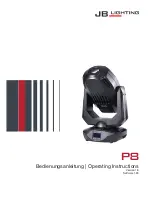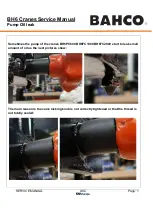
14
I-ZDEG-EU-1312-394-03
4.5 MRI Information
Nonclinical testing has demonstrated that the Zenith TX2 TAA Endovascular
Graft is mr Conditional according to ASTM F2503. A patient with this
endovascular graft may be safely scanned after placement under the following
conditions.
• Static magnetic fields of 1.5 and 3.0 Tesla
• Maximum spatial magnetic gradient field of 720 Gauss/cm
• Maximum MR system reported, whole-body-averaged specific absorption
rate (SAR) of 2.0 W/kg (Normal Operating Mode) for 15 minutes of scanning
or less (i.e., per scanning sequence)
Static Magnetic Field
The static magnetic field for comparison to the above limits is the static
magnetic field that is pertinent to the patient (i.e., outside of scanner covering,
accessible to a patient or individual).
MRI-Related Heating
1.5 Tesla Temperature Rise
In nonclinical testing, the Zenith TX2 TAA Endovascular Graft produced a
temperature rise of 1.2°C (scaled to an SAR of 2.0 W/kg) during 15 minutes
of MR imaging (i.e., for one scanning sequence) performed in a MR 1.5 Tesla
System (Siemens Magnetom, Software Numaris/4).
3.0 Tesla Temperature Rise
In nonclinical testing, the Zenith TX2 TAA Endovascular Graft produced a
temperature rise of less than or equal to 1.3°C (scaled to an SAR of 2.0 W/kg)
during 15 minutes of MR imaging (i.e., for one scanning sequence) performed in
a MR 3.0 Tesla System (General Electric Excite, HDx, Software G3.0-052B).
Image Artifact
The image artifact extends throughout the anatomical region containing the
device, obscuring the view of immediately adjacent anatomical structures
within approximately 20 cm of the device, as well as the entire device and its
lumen, when scanned in nonclinical testing using the sequence: Fast spin echo,
in a MR 3.0 Tesla System (General Electric Excite, HDx, Software G3.0-052B), with
body radiofrequency coil.
For all scanners, the image artifact dissipates as the distance from the device
to the area of interest increases. MR scans of the head and neck and lower
extremities may be obtained without image artifact. Image artifact may be
present in scans of the abdominal region and upper extremities, depending on
distance from the device to the area of interest.
For US Patients Only
Cook recommends that the patient register the MR conditions disclosed in
this IFU with the MedicAlert Foundation. The MedicAlert Foundation can be
contacted in the following manners:
Mail:
MedicAlert Foundation International
2323 Colorado Avenue
Turlock, CA 95382
Phone:
888-633-4298 (toll free)
209-668-3333 from outside the US
Fax:
209-669-2450
Web:
www.medicalert.org
5 POTENTIAL ADVERSE EVENTS
Adverse events that may occur and/or require intervention include, but are not
limited to:
• Amputation
• Anesthetic complications and subsequent attendant problems (e.g.,
aspiration)
• Aneurysm enlargement
• Aneurysm rupture and death
• Aortic damage, including perforation, dissection, bleeding, rupture and
death
• Aorto-bronchial fistula
• Aorto-esophageal fistula
• Arterial or venous thrombosis and/or pseudoaneurysm
• Arteriovenous fistula
• Bleeding, hematoma, or coagulopathy
• Bowel complications (e.g., ileus, transient ischemia, infarction, necrosis)
• Cardiac complications and subsequent attendant problems (e.g., arrhythmia,
tamponade, myocardial infarction, congestive heart failure, hypotension,
hypertension)
• Claudication (e.g., buttock, lower limb)
• Death
• Edema
• Embolization (micro and macro) with transient or permanent ischemia or
infarction
• Endoleak
• Endoprosthesis: improper component placement; incomplete component
deployment; component migration and/or separation; suture break;
occlusion; infection; stent fracture; stent corrosion; graft material wear;
dilatation; erosion; puncture and perigraft flow
• Entry-Flow
• Fever and localized inflammation
• Genitourinary complications and subsequent attendant problems (e.g.,
ischemia, erosion, fistula, urinary incontinence, hematuria, infection)
• Hepatic failure
• Impotence
• Infection of the dissection, device or access site, including abscess formation,
transient fever and pain
• Local or systemic neurologic complications and subsequent attendant
problems (e.g., stroke, transient ischemic attack, paraplegia, paraparesis,
spinal cord shock, paralysis)
• Lymphatic complications and subsequent attendant problems (e.g., lymph
fistula, lymphocele)
• Occlusion of device or native vessel
• Pulmonary/respiratory complications and subsequent attendant problems
(e.g., pneumonia, respiratory failure, prolonged intubation)
• Renal complications and subsequent attendant problems (e.g., artery
occlusion, contrast toxicity, insufficiency, failure)
• Surgical conversion to open repair
• Vascular access site complications, including infection, pain, hematoma,
pseudoaneurysm, arteriovenous fistula
• Vascular spasm or vascular trauma (e.g., ilio-femoral vessel dissection,
bleeding, rupture, death)
• Wound complications and subsequent attendant problems (e.g., dehiscence,
infection)
6 POTENTIAL RISKS AND BENEFITS
The device is an implantable endoprosthesis intended to reduce the risk of
rupture. The hazards associated can be categorized as device-related (e.g., lack
of sterility, toxicity, biodegredation of the device), deployment-related (e.g.,
failure to traverse the iliac arteries, misdeployment), performance-related (e.g.,
migration, stent fracture, graft infection, late endoleak), and disease-related
(e.g., extension of the dissection, malperfusion, and aneurysm degeneration).
The consequent risks to the patient depend on the incidence and effects of
each hazard, which have been explored in a number of experimental and
clinical insertions. These risks of endovascular repair must be weighed against
the risks associated with the current alternative forms of thoracic aortic
dissection management.
Implantation of the Zenith TX2 Dissection Endovascular Graft with Pro-Form is
likely a less invasive procedure than open surgical repair. Therefore, potential
clinical benefits to patients treated with the Zenith TX2 Dissection Endovascular
Graft with Pro-Form may include a suitable dissection repair with less risk
and fewer complications than those treated with open surgical repair. Zenith
TX2 Dissection Endovascular Graft with Pro-Form patients may benefit from
a reduced risk of serious treatment-related complications, shorter anesthesia
times, shorter procedure times, reduced procedural blood loss and reduced
need for blood products.
7 PATIENT SELECTION AND TREATMENT
(See Section 4.2, Patient Selection, Treatment and follow-Up)
7.1 Individualization of Treatment
Cook recommends that the Zenith TX2 Dissection Endovascular Graft with
Pro-Form and the Z-Trak Plus Introduction System component diameters
be selected as described in Tables 1, 2 and 3. All lengths and diameters
of the devices necessary to complete the procedure should be available to
the physician, especially when preoperative case planning measurements
(treatment diameters/lengths) are not certain. This approach allows for greater
intraoperative flexibility to achieve optimal procedural outcomes. The risks and
benefits previously described in Section 6, PoTENTIaL rISkS aND bENEfITS
should be carefully considered for each patient before use of the Zenith TX2
Dissection Endovascular Graft with Pro-Form and the Z-Trak Plus Introduction
System. Additional considerations for patient selection include, but are not
limited to:
• Patient’s age and life expectancy
• Co-morbidities (e.g., cardiac, pulmonary or renal insufficiency prior to
surgery, morbid obesity)
• Patient’s suitability for open surgical repair
• Ability to tolerate general, regional, or local anesthesia
• Ilio-femoral access vessel size and morphology (thrombus, calcification and/
or tortuosity) should be compatible with vascular access techniques and
accessories of the introduction profile of a 20 French to 22 French vascular
introducer sheath, including:
• Adequate iliac/femoral access compatible with the required introduction
systems, and
• Radius of curvature greater than 35 mm along the length of aorta
intended to be treated by Straight or Tapered Component.
• Non-dissected/aneurysmal aortic segment (fixation site) proximal to the
dissection:
• with a length of at least 20 mm,
• with a diameter measured outer wall to outer wall of no greater than 38
mm and no less than 20 mm, and
• with localized angulation less than 45 degrees.
The final treatment decision is at the discretion of the physician and patient.
8 PATIENT COUNSELING INFORMATION
The physician and patient (and/or family members) should review the risks and
benefits when discussing this endovascular device and procedure, including:
• Risks and differences between endovascular repair and open surgical repair
• Potential advantages of traditional open surgical repair
• Potential advantages of endovascular repair
• The possibility that subsequent interventional or open surgical repair may
be required after initial endovascular repair
In addition to the risks and benefits of an endo vascular repair, the physician
should assess the patient’s commitment to and compliance with postoperative
follow-up as necessary to ensure continuing safe and effective results. Listed
below are additional topics to discuss with the patient as to expectations after
an endovascular repair:
• The long-term performance of endovascular grafts has not yet been
established. All patients should be advised that endovascular treatment
requires life-long, regular follow-up to assess their health and the
performance of their endovascular graft. Patients with specific clinical
findings (e.g., endoleaks, persisting flow in false lumen or changes in the
structure or position of the endovascular graft) should receive enhanced
follow-up. Specific follow-up guidelines are described in Section 12,
ImaGING GUIDELINES aND PoSToPEraTIvE foLLoW-UP.
• Patients should be counseled on the importance of adhering to the follow-
up schedule, both during the first year and at yearly intervals thereafter.
Patients should be told that regular and consistent follow-up is a critical part
of ensuring the ongoing safety and effectiveness of endovascular treatment
of dissections. At a minimum, annual imaging and adherence to routine
postoperative follow-up requirements is required and should be considered
a life-long commitment to the patient’s health and well-being.
• The patient should be told that successful repair does not arrest the disease
process. It is still possible to have associated degeneration of vessels.
• Physicians must advise every patient that it is important to seek prompt
medical attention if he/she experiences signs of graft occlusion or rupture.
Signs of graft occlusion include, but may not be limited to, pain in the hip(s)
or leg(s) during walking or at rest, and discoloration or coolness of the leg(s).
Rupture may be asymptomatic, but usually presents as pain, numbness,
weakness in the legs, any back or chest pain, persistent cough, dizziness,
fainting, rapid heartbeat, or sudden weakness.
The physician should complete the Patient Card and give it to the patient so
that he/she can carry it with him/her at all times. The patient should refer to the
card anytime he/she visits additional health practitioners, particularly for any
additional diagnostic procedures (e.g., MRI).
9 HOW SUPPLIED
• The Zenith TX2 Dissection Endovascular Graft with the Z Trak Plus
introduction system is supplied sterilized by ethylene oxide gas, is preloaded
onto an introduction system, and is supplied in peel-open packages.
• The device is intended for single use only. Do not attempt to re-sterilize the
device.
• Inspect the device and packaging to verify that no damage has occurred as
a result of shipping. Do not use this device if damage has occurred or if the
sterilization barrier has been damaged or broken. If damage has occurred,
do not use the product and return to Cook.


































